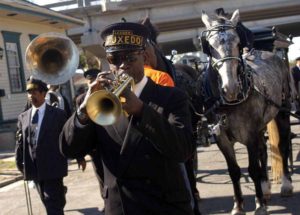
New Orleans is back in business. From a perspective viewed over the rim of a Hurricane cocktail sitting in Pat O’Brien’s Kelly-green décor in the French Quarter, it is as if the old city has continued on unchanged.
The cocktails are flowing and the chefs are back in their kitchens. This autumn the streetcars got back in business.
The joint is jumping and the crowds are moving in both directions as they amble along the French Quarter. The musical, the historic, the seedy and the unsavoury all jostle for attention in the noisy crowded street. The party has resumed, and the sound from Pat O’Brien’s, Latrobe’s on Royal and the Hard Rock Café on Peter St spill out on to the streets around.
New Orleans is a state of mind. The city has to be revisited often just to be reminded of how much life is there. As you wander through the French Quarter there are crowds of people standing on the balconies throwing beads to passers by, reliving the tradition of a city in a Mardi Gras parade that never stops. In the heart of America’s bible belt, New Orleans is a welcome hedonistic bacchanalian celebration of life.
This is one of the few American cities where you can ramble the streets in an aimless search and always come up with something unexpected and interesting.
It has more restaurants now than before the hurricane struck. The hotels have been refurbished and the French Quarter has never looked spicker and cleaner. Streets are cleaned daily, leading to a new fresher feeling than there was before. Carnival Cruise lines have brought back the big ships.
Even since Mardi Gras in February, your correspondent’s last visit there, things have improved immeasurably.
Meanwhile, the city has climbed right up through the ranks of most visited American cities for Irish customers. Hotel bookings websites rate it as the second most booked indirect destination, behind Las Vegas. The fact that it offers some of the best room rates helps, rooms cost from $140-$200 depending on the time of the year.
Some aspects of New Orleans recovered more slowly than others. While the tourist districts were the ones that escaped damage and were quick to return, they were short of staff for a year after the hurricane struck.
Restaurants such as the famous Brennan’s Restaurant, beloved of Hemingway, where the breakfast menu comes with a wine list, Arnaud’s in Bienville Street and the Court of Two Sisters in Royal Street, two of the best in the States, were able to win back the affection of the tourists almost immediately. The Ogden Museum of Southern Arts got through the crisis with its collection intact.
Other sectors have had a more traumatic time. The malls were devastated and although they are winning back old tenants New Orleans is best shopped on the old traditional streets like Magazine Street. But it was never that sort of a town.
Getting out into the hinterlands the region’s gator and Gumbo product is still intact. The New Orleans cookery schools are back in business and Louisiana’s most ancient residents can be visited in the swamps on boat tours within a few miles of the city.
It is a respite form the partying, gliding along past Cypress trunks, thick marsh reeds and the brackish watery avenues of the Louisiana bayou amid alligators, nutria, gar, turtles, fish and birdlife.
Gators are the stars of the show, but there is much more to see while everyone is trying to find another alligator. There are half a dozen swamp tour operators. Other options include cooking tours, the unique cemeteries, the he Warehouse/Arts District and the Garden District and the acres of parks with the trees sprinkled with Spanish Moss.
The city is surrounded by plantations where visitors can get a flavour of life for slaves and owners in the sugar era, and a darker side to the big house history – a slave revolt which was ruthlessly suppressed.
New Orleans has a longer history than most American cities and much of it is a history of victims.
Out at West End Boulevard. close to the Robert E Lee Boulevard there is a large Celtic cross, a reminder of our own connection with New Orleans.
It is a monument to the forgotten Irish who died while digging the New Basin Canal between Ponchartrain and the American section of new Orleans. Work on the three miles of canal commenced in 1832 and finished in 1838.
The slaves were regarded as too valuable to use so Irish workers arriving in the holds of cotton boats were used instead risking their lives in hazardous backbreaking work for a chance to earn $1 a day.
No one knows how many died estimates ranging from 4,000 to 30,000 with a consensus of around 20,000. Many were buried with no marking in the levee and roadway fill beside the canal. The lifespan of the Irish canal worker was reckoned at about 12 days, victims of yellow fever.
Most of it is now filled in and covered by the Ponchartrain Expressway, the Celtic cross the only monument to the thousands who died.
There are victims still. Beyond the French Quarter New Orleans is still a city in recovery. Everybody mentions Hurricane Katrina. There are Katrina tours, which bring you through the neighbourhoods worst affected by the levee breach.
A few neighbourhoods still bear the marks, but the pain is more tangible in the tales of the local residents and how they descended from first world comfort to life on the brink in the course of one night. The photographs which were passed around our tour bus were horrible.
You will never listen in the same way to the lovely ballad about Lake Ponchartraine.
“New Orleans is a city in recovery, but we know that we have to move on,” Kelly Schulz of New Orleans CVB says.
- Stroll down Bourbon Street, Pat O’Brien’s, Preservation Hall, and the Famous Door, and Harrah’s Casino.
- Blaine Kern’s Mardi Gras World. See artists and sculptors creating papier mache and fiberglass props for the world’s largest fleet of floats. Tours, video history, royalty costumes, and gifts shop, cooking school. Sculpted figures from Kern Studios in Europe and the Orient. Also cookery demonstration. 504.361.7821
- Ogden Museum of Southern Art. The Ogden Museum of Southern Arts is an affiliate of the Smithsonian Institution and will include the most comprehensive collection of Southern art in the world. 504.539.9600
- Arnaud’s. Southern Living says: “You don’t want to miss this.” Charming, gracious, fun and delicious. After dinner, experience the glorious gowns in their Mardi Gras Museum. 504.523.0611
- Court of Two Sisters Restaurant located in the heart of the French Quarter reopened on Tuesday, November 29th! Their large, open-air courtyard and three elegant dining rooms offer the perfect setting for every occasion. 504.522.7261
- Brennan’s Restaurant. Famous for breakfast, Tennessee Williams’ table is still there. Enjoy Bananas Foster, a Brennan creation, and other culinary phenomenons. 504.525.9713
- For more information see www.neworleanscvb.com
- Eoghan Corry flew to New Orleans with Delta via Atlanta.
- He stayed at Monteleone Hotel, 214 Royal Street, New Orleans, LA 70130 +1504.523.3341
- For local city tour options see Gray Line Tours 2 Canal Street Suite 2500 New Orleans, LA 70130-1857 +1504) 587-0709 or +1504) 569-1401 www.graylineneworleans.com



